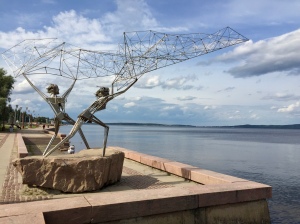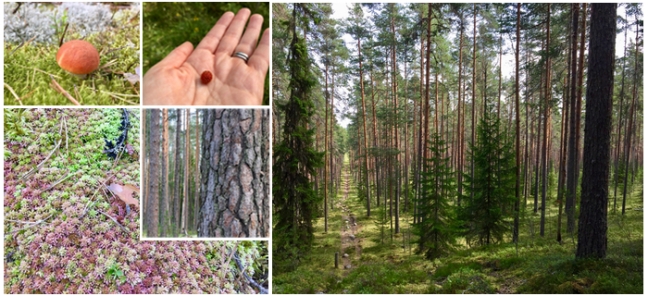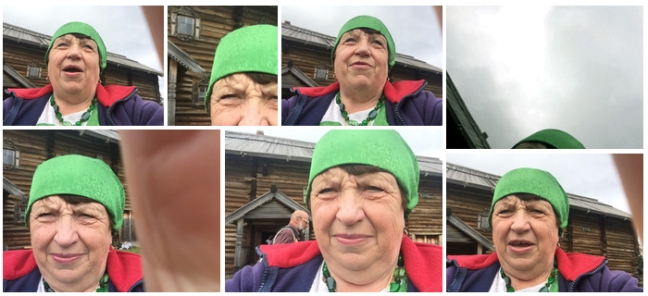
“For this I weep all my days
and throughout my lifetime grieve
that I swam from my own lands
and came from familiar lands
towards these strange doors
to these foreign gates.”
The Kalevala by Elias Lönnrot
The train stopped. The announcer spoke first in Russian then in English. Five minutes, she said. 10:37. I looked out the window. Travellers poured out onto the platform and lit up. Venders met them with trays of smoked fish and wild berries. I watched smokers cough into their berry breakfasts and then rush back onto the train. It jerked back into action, leaving the sleepy hollow of Svir. 10:42. Five minutes exactly.
Petrozavodsk
As the train clattered and swayed, Hubby read aloud from Gogol’s The Nose. Miles of Silver Birch flashed past. We crossed bridges spanning sometimes marshy streams, other times vast raging rivers. Through clearings, we spotted little villages. Precarious stacks of chopped wood leaned against wooden houses. These are the summer dachas*, in happy contrast to the 5 story Soviet flats brought in by First Party Secretary, Gustav Khrushchev (1958). In many parts of Russia these are being replaced with modern high rises, but in Karelian towns they still dominate.
Petrozavodsk is the capital of Karelia. Founded by Peter the Great in 1703 to create a passage to Europe, it literally means ‘Peter’s factory’. Peter the Great travelled extensively. He was hugely influenced by Europe and is credited with the modernisation of Russia (Dutch heating systems, furniture and decor styles, industry). He even banned beards – paintings of Peter usually depict him clean shaven.

In Petrozavodsk you will find (possibly the only) Round Square in the world (now renamed Lenin Square and stands in the middle, peasant cap in hand), the Onega Lake Embankment, the Karelian Museum and the Eternal Flame (found in every Russian city to commemorate the unknown soldier in … plenty of wars) and Theatre Square.

Because of receding glaciers, said tour guide Tatiana, Karelia is a district of approximately 60,000 lakes and 27,000 rivers. Fishing is a national pastime and no menu has less than 15 different ways to eat sea food. Hands down, best restaurant in Petrozavodsk is Karelskaya Gornitsa – rich, tasty Karelian food in wooden cabin-like surroundings.
Incidentally, pre-Peter the Great, Karelia was Finnish territory. The Fins have managed to take it back a few times and succeeded. From 1941-1944 Petrozavodsk was occupied by the Fins. They chopped Lenin’s head off in the Round Square (Lenin is no longer headless). Karelia is also the home of the Kalevala, the national poetry of Finland, held dear by the Russian/Finish population of this northern territory so close to the arctic circle.
Taiga
On our last day in Petrozavodsk, tour guide Tatiana took us to the Taiga. The Taiga is a type of dense forest populated by Pine, blueberry, lichen, Birch and Spruce. There we learnt which mushrooms to pick and which not to, how bears forage and hibernate and the healing properties of lichen. We were warned to bring mozzie spray, but still got bitten through our trousers. Those MONSTERS!

On the potholed way to the Taiga we stopped to use a loo at a garage. It was locked. Sign said ‘Closed for lunch’. There is a Russian saying, said Tatiana: “In Russia there are two problems: fools and roads.” I would have to add, toilets.
Valaam
On a glorious day for hydrofoiling we headed for a working monastery on the island of Valaam. I’ve never see a lake like Lake Ladoga. For a large part of the journey we could not see land in any direction. Valaam is beautiful in an ostentatious way: grand painted cupolas, gold leaf this, gold leaf that, VIP hotel. Sadly it’s one of those Orthodox Monasteries still deeply connected to political power. Putin is said to be a patron. We donned head scarves and wore skirts (not Hubby of course), listened to a beautiful acapella men’s choir, wondered around the island, dodged some cats and ate lunch with the monks.
Kizhi
Kizhi is an island on the Finnish border. We crossed Lake Onega again by hydrofoil. In pre-Soviet days Kizhi was home to prosperous tradesmen, artisans, carpenters and farmers growing oats and barley. Now its an open air museum. Jurgen, our English-speaking, Karelian-born, Finish-looking guide began by warning us that the Island is the home to several venomous snakes.
Though the story of Kizhi is about a people and way of life long lost, it’s also about the restoration of the church. In 1937, during Stalin’s purges, the last priest of Kizhi was shot and killed, accused of treason. The real problem was that he was a priest. Stalin couldn’t allow any ideology to threaten Communism. The summer church is Finnish Orthodox and a UNESCO World Heritage site.
Builders call the restoration project the ‘Stairway to Heaven’. In winter they carve and restore the domes and in summer they work on site lifting and placing the 32 cupolas (32 for the age of Jesus). Pine is brought over from the mainland by sled on ice, cut in February when sap is still inside so that the wood is more durable.
The church iconography dates to the 17th century and the focus is on Christ’s Transfiguration. It’s unique in Russia – no golden frames, no fretwork or excessive decoration – peaceful.
I’m embarrassed to say that all three of us – me, Hubby, Mamma – did the dress-up-in-Karelian-clothes thing. We posed in front of the lake and wooden church while a somewhat technologically-challenged Babushka took our photo. Below is what we found when we examined the camera:

SMALL PRINT:
P.s. Dachas are simple countryside wooden houses where Russians spend their summer growing and pickling vegetables for winter.
P.p.s. Tour guide Tatiana told us that one of the tortures of the Gulags was to bring a man into the Taiga, strip him and leave him in the forest over night during the hight of summer for the mosquitos to feast on him. A few days later I told this story to friends in Moscow, and by mistake used the word Goulash instead of Gulag – Hubby has NOT let me forget that.
P.p.p.s. I’m sorry to report that we saw no snakes in Kizhi. If you visit the island during winter, you will be transported by bus – yes – over the ice.

















Gosh what a lovely account of your journey.You should write a book about your many exciting trips.You are a talented writer.x
LikeLike